The syncretic faith, an amalgamation of Hinduism, Sikhism and Sufism, which Sindhis in India follow sees them celebrating a myriad of festivals. Sindhis will be found bowing their heads in Hindu temples, Sikh gurudwaras or dargahs of Sufi pirs with equal reverence.
The Sindhis follow the lunar calendar and refer to tipno for important days and festivals.
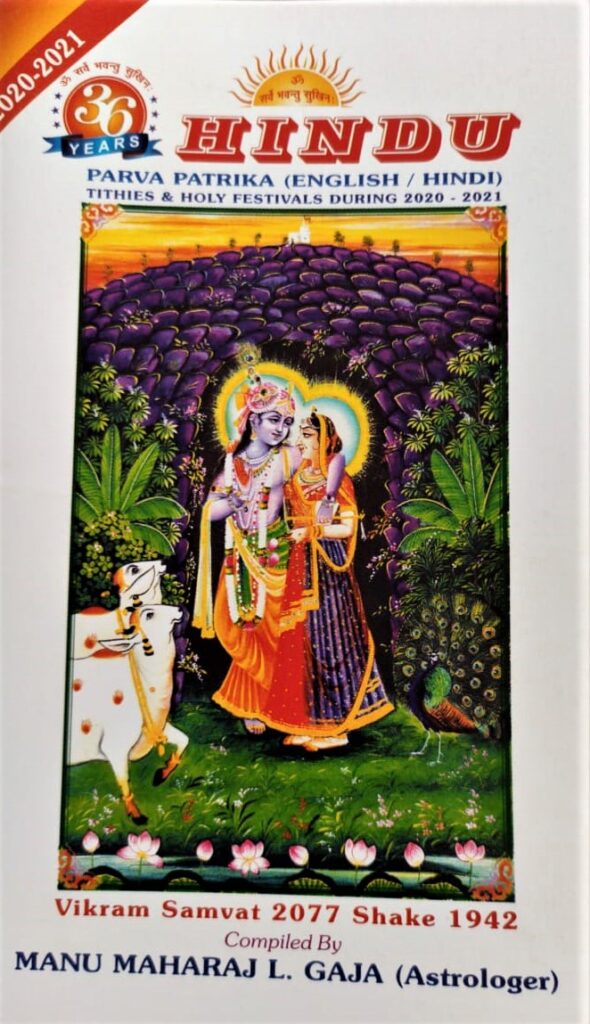
Sindhis refer to Tipno, the Sindhi lunar calendar, for the tithis and festivals of Sindhi community. It is usually a booklet that helps to track the phases of moon and important dates in every month. It also mentions the birth and death anniversaries of saints. Sometimes, a tipno may have prayers and aartis to be chanted at various festivals. It is often published by devotees in honour of their ancestors and distributed free of cost to all.
A tithi is the time in between two moonrises. It begins at varying times of the day and may vary in duration from 19 to 26 hours.
The New Moon day (Umasah/ Amavasya) marks the beginning of the new month. The first half of the lunar month is called Chandoki /Shuklapaksh or the waxing phase and the second half of the lunar month is called Undhayu/Krishnapaksh or the waning phase. Each month is roughly 29.5 days, the time that the moon takes to pass through each of its phases from new moon to full moon and return to its original position. The months of the lunar calendar are named after the zodiac signs the sun enters during that period.
Names of the days of the Lunar Month
Umasah – Moonless night
1 – Ekam (Chandoki starts)
2 – Beej (Chand)
3 – Teej
4 – Chouth
5 – Panchami
6 – Chhatt
7 – Satte/ Saptami
8 – Ashtami
9 – Naomi/Navami
10 – Dasseh
11 – Gyaars
12 – Baars
13 – Ters
14 – Choudas
Poonam – Full moon night
Undhayu starts from Ekam to Choudas
The six days of every lunar month such as Poonam (the full moon day), Umasah (no moon day), Gyaars (the 11th day after both Umasah and Poonam), Chand (2nd day of the lunar month), and Ganesh Chauth (the fourth day after Poonam) are important tithis for Sindhis.
On Gyaars day, Sindhis do daan, and refrain from eating grains, onion or garlic. Gyaars falls twice every month.
On Umasah, daan is given to the priests and the needy in the name of ancestors. Any Umasah that falls on a Monday is known as Soomathi Umasah or Goongi (silent) Umasah. People do not talk to anyone till they have had a bath, or, in earlier days, till they have taken a dip in a river or any source of water.
DAAN -A lot of importance is placed on charity, called daan, among Sindhis. Any important event or festival calls for charity. Seasonal fruits, vegetables and grain, ghee or special food cooked during festivals, etc, along with dakshina (money) is given to the priests, the temple and the needy.
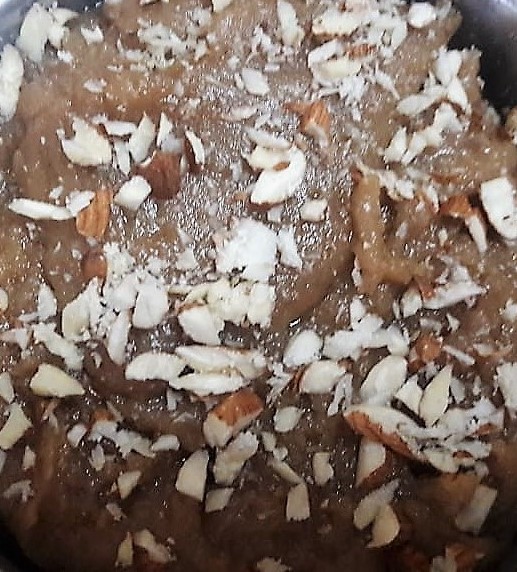
On Chand, atte jo seero (Kanaw Prasad – a preparation of wheat flour roasted in ghee with sugar and cardamom) and coconut are offered to the deity. ‘ Akho’- a pinch of raw rice with milk and sugar is offered to a water body such as sea, river, lake or even a pot or a tap as they are sources of water. Many Sindhis have taam (festive food) that night. No dal or fulkas (whole wheat flatbread that is roasted on a griddle/ tava) are made as they are considered too ordinary to be made on an auspicious day. Instead, puris with a potato preparation or saeeyu chona (sweet vermicelli with a dry preparation of spicy legumes) are made for dinner.
Pic: Kanaw Prasad by Purnima Dalwani , Mumbai
Akho- Raw rice, sugar, milk and flowers constitute an akho, which is offered to any water body such as sea, river, lake or even a pot or a tap to worship Dariyalal/ Varun Dev -the God of Rivers. Sindhis offer akho to any convenient water source every morning after prayers and go to the sea or river on festivals.
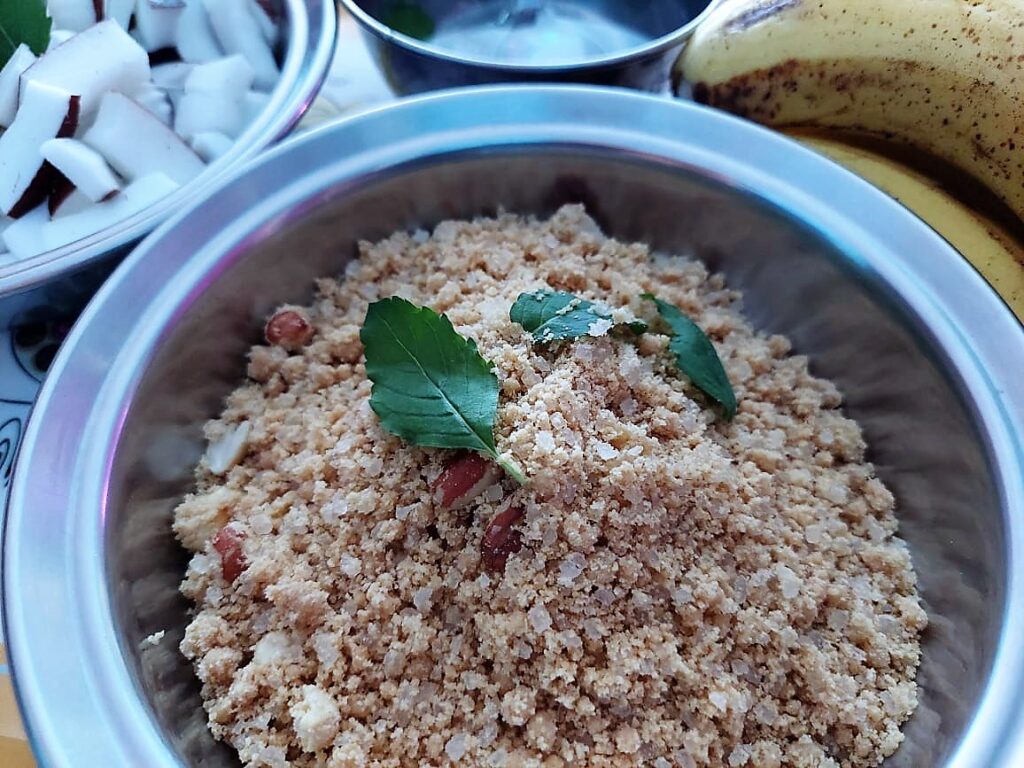
On Poonam, the katha (reading of the story from a religious book) of Lord Satyanarayan ( a form of Lord Vishnu) is read. Satnaran ji kutti (a dry preparation of wheat flour roasted in ghee with sugar), coconut slices, peanuts, dry fruits and chopped fruits are offered to the deity and distributed to all. Many devotees have one meal a day –ekannu.
Pic : Satnaran ji Kutti
On Ganesh Chauth, Lord Ganpati is revered and salt free food is eaten.
Over and above these days, there are some important festivals that Sindhis celebrate. Each festival is observed with a distinct set of rituals. Food specific to the festival is prepared. Here is the list of important festivals and events that Sindhis celebrate, though the observance of the festivals may vary from one family to another, depending on the region of Sindh they come from or their personal beliefs.
The Sindhi lunar months and their approximate solar calendar equivalents
| Solar Months | Lunar Months |
| March -April | Chet-Vesakh |
| April- May | Vesakh – Jeth |
| May-June | Jeth -Aakhar |
| June -July | Aakhar -Saavan |
| July -August | Saavan – Bado |
| August – September | Bado – Assoo |
| September -October | Assoo – Katti (Kartak) |
| November -December | Manghir – Poh |
| December- January | Poh – Mangh |
| January – February | Maagh- Faag |
| February- March | Faag – Chet |
Adhik Maas/ Purshottam Jo Mahino
A lunar year has approximately 354 days, while a solar year has 365 days. This leaves a 11-days, 1 hour, 31 minutes and 12 seconds difference between the two. Over the period of 33 years, there will be a lag of one year between solar and lunar calendars because of the successive difference. An extra (13th) month is added into the lunar calendar every three years to align the two calendars. This month is called Adhik Maas or Purshottam Maas. No important ceremonies or events are held in this month. It is a time for praying, fasting, charity and self-improvement.
1. Cheti Chand (March-April)
Sindhis have always been water worshippers with the mighty Sindhu (Indus) river flowing through Sindh and the huge expanse of Arabian Sea in the south of Sindh. The birth of Avatar of Varun Devta (God of Rivers), Jhulelal or Uderolal is celebrated on Cheti Chand, – the second day of the month Chet of Sindhi lunar calendar. It is also the beginning of the New Year of Sindhis. Some businessmen start new account books on this day, while others on the eve of Diwali. New ventures are commenced on this auspicious day.
Kanaw Prasad is offered to the deity. The houses are lit up and people go to the sea, river or any water body dancing and singing bhajans to offer ‘akho’ and immerse Behranno Saheb, a mound shaped dough representing the body of Jhulelal, adorned with sindoor for clothes and studded with cloves and cardamom for ornaments. Thayri (sweet rice) and cooked channa are offered to the water body as prasad. A 5 – edged dough jyot(lamp) is also lit and floated in the water body.
Annual fairs are held and sarghus(processions) are taken out on the sea or river front. People participate with colourful floats depicting Jhulelal’s life and Sindhi culture. Some devotees dress up as gods and goddesses.
Pallo/Pallav
Pallo is a prayer offered to the almighty for the well-being of everyone. The devotees cover their heads and extend the end of their sarees, scarfs or shirts in an act of complete surrender to God and sing ardas – a devotional song beseeching God to bless everyone. Chhatto/ Chhandho (water/ Gangajal sprinkled over the devotees) is done to bless everyone. Pallo payanu is an important ritual of worship to Jhulelal.
2. Norta – Nandda Ekanna (Navratri) (March-April)
The Norta are celebrated for 9 days. These begin on ekam – the first day of Chet after Umasah (moonless night). The devotees keep ekaanna (have only one meal a day) and worship Durga Mata. For these nine days, people eat satvik food (with no onion or garlic) only in the evening after the aarti. They refrain from consuming alcohol or smoking.
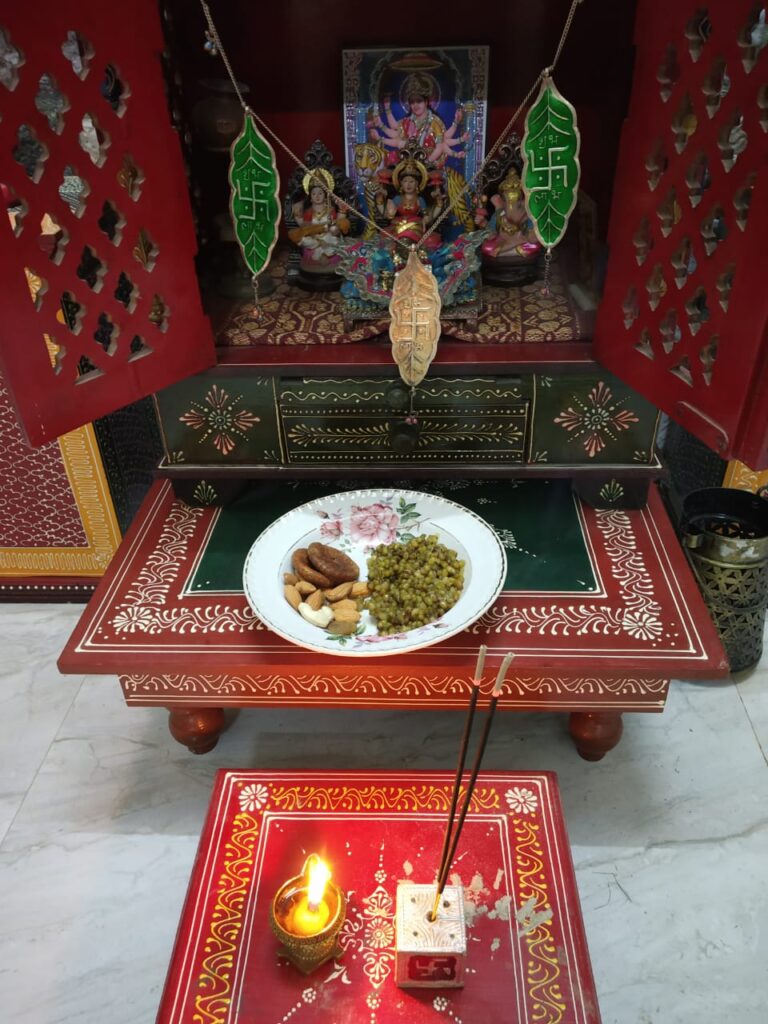
Baakra (sweet moong) , bhugra (roasted channa) and sev are offered to the Goddess on the seventh day.
Pic Credit: Diya Davara, Ahmedabad
The eighth day is celebrated as Durgashtmi. Offerings of ghee, kheer (rice cooked in milk) and sesame seeds are done in the havan (holy fire). Eight niyaniyu (young girls) and a kaang ( a boy) – all should have not attained puberty- are worshipped and given prasad(offering) of sweet rice and milk. The girls are given gifts of cosmetics or accessories that they can use to adorn themselves. Dakshina (a small amount of money) is given to children.
3. Ram Navami (March- April)
The ninth day of the month of Chet and the last day of the Norta is celebrated as the day Lord Ram was born. Devotees read Akhand Ramayan, perform a havan and offer prasad.
4. Hanuman Jayanti (March-April)
The full moon day of the month of Chet is the birthday of Lord Hanuman. Devotees read Hanuman Chalisa and offer rue (dhatura) flowers to Hanuman. They eat only sweets and avoid salt.
3.Akha Teej (April – May)
Akha Teej/Akshaya Tritya falls on the third day after Umasah (moonless night) in the month of Vaisakh. This day is dedicated to Lord Vishnu who brings good fortune and victory in life.
New earthern pots are bought for the house. Since this day falls in blazing hot summer in India, cool sherbet and water is offered to passersby along with prasad. Earthern pots, sugar, seasonal fruits like mangoes and melons are donated to priests and the needy.
This day is considered auspicious for starting businesses, house-warming ceremonies, weddings, etc. People buy gold or silver as this brings abundance in the house.
4. Chaaliyo Saheb /Navarojo (July – August)
Chaaliyo is based on the solar calendar and always starts on 16th July and ends on 24th August. Around 939 AD, Marikhshah, the Sultan of Sindh, wanted his Hindu subjects to convert forcibly to Islam. The Hindus in desperation prayed to Lord Varun and Sai Jhulelal was born. People prayed and performed havans for forty days on the banks of river Sindhu, pleading Lord Jhulelal to help them. When Marikhshah attacked the temple of Jhulelal, Lal Sai destroyed his kingdom. The Sultan realised that he was against a Greater Power and promised to treat Hindus and Muslims alike.
The devotees observe Chaaliyo Saheb for forty days to thank Jhulelal Sai. They neither shave nor wear new clothes and sleep on the floor. They worship Lord Varun, sing his praises and pray for their salvation. Akho is offered during morning prayers. Bhajans are sung in the temples. Some people fast for either nine (Navarojo), twenty-one or forty days.
On the forty first day, Bahraano Saheb is worshipped and a surghus is taken out on the sea or river front. A vigorous Sindhi dance called ‘Chhej’ is performed by men.
5. Saavan jo Mahino (July-August)
One of the holiest months, Saavan is the month of Lord Shiv. Devotees eat only satvik food once a day the entire month, and worship Lord Shiv every day. They bathe the Shivling with milk and water, offer bilva leaves and flowers. Mondays of this month are considered especially auspicious. Many Hindu festivals fall in this month.
6. Ghogho/Ghoghro/ Nag Panchami (July- August)
The 5th day after Umasah (moonless night) in the lunar month of Saavan is Ghoghro. Ghoghro was the brother of snakes. Women roast five thikkariyun (whole wheat sweet flatbread roasted in round or square shape) a day before. They offer milk and the thikkar to snakes under a peepal tree, and do puja with a red cloth, cardamom and cloves, which are later placed in the house treasury for prosperity and abundance.
7. Choumasa jo Virt (July- August)
This vrat is observed for 16 consecutive Mondays starting from the month of Saavan till the month of Kartak which comes to four months. The 4th day after Diyari (Diwali) is Ganesh Chauth when the Udyapan (the final puja to end the vrat) of the vrat is performed. Sindhi women worship Lord Shiv and Goddess Parvati and abstain from non – vegetarian food for these months and eat only one satvik meal (no onion or garlic) before sunset every Monday. The vrat is observed for four consecutive years at a time. This vrat is also called Mansa Vacha (One that helps fulfills one’s wishes).
8. Rakhri (Raksha Bandhan) (August)
This day is observed on Poonam (full moon) day of Saavan. Traditionally, the family priest ties a scared thread of rakhri on the wrists of all family members. Even the front door, the earthen water pot, the tap and idols of Gods are tied rakhris.
Rakhri also celebrates the love between brothers and sisters. Sisters tie rakhri – the sacred thread- on the wrists of their brothers seeking protection. Brothers promise the same and give gifts to the sisters.
9. Teejri (August)
This festival falls on the third day after Poonam in the month of Saavan. Single or married women apply mehendi (henna) the day before. They wake up before dawn, eat lolas (sweet whole wheat roasted flatbread) and perform puja. During the day, they fast with no food or water, play games and sing songs. They break their fast at night after making an offering to the moon.
Single women observe this fast to get good husbands, while married women observe it for a long successful marriage.
10. Nandi Satte and Vadi Satte (August)
Both these days fall on the 7th and 21st day of the month of Saavan respectively. Those who observe Ghogho, usually do not observe Nandi Satte. These days are celebrated to please Goddess Jog Maya (Sitala Maa) who protects the children from diseases like chicken pox, measles. etc, if appeased. If angry she causes these ailments. Hence mothers offer the Goddess lolas (sweet roasted flatbread) or moniyus (sweet fried flatbread) made a day before. The family eats cold food such as dal ja phulka (parathas stuffed with dal), koki (spiced flatbread), phulka – bhaji (vegetable preparation), chaat, curd rice – all made the day before. The spread for Vadi satte is more elaborate with pakaan ( layered bread made of maida and fried), mawa samosas and besdnyu ( fried spiced crisp puris).The stove or sigri on which the food is cooked is cooled and worshipped. No food is made on that day.
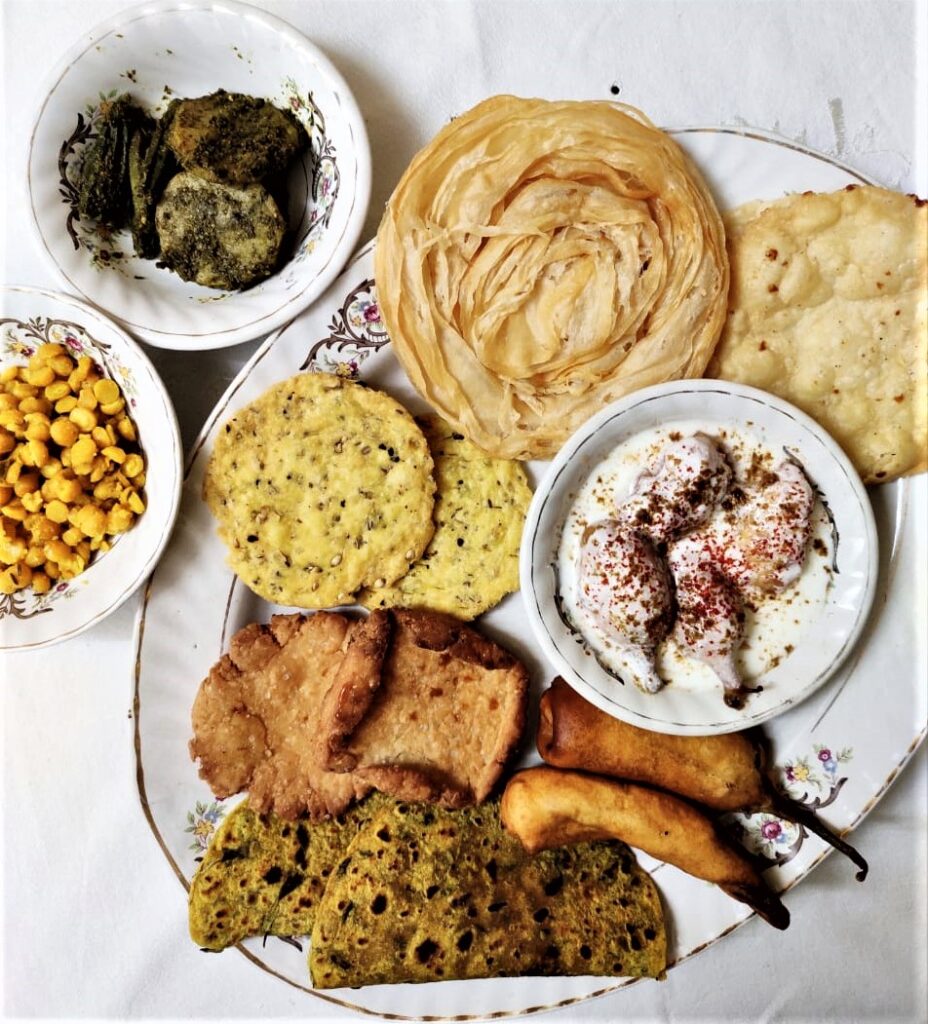
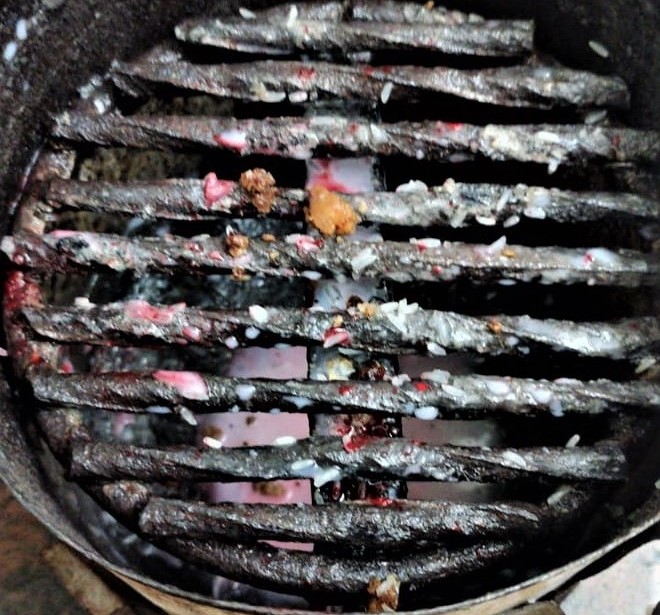
The sigri is cooled and worshipped on Satam in Navratri
2.THE SIGRI IS COOLED AND WORSHIPPED
Pics by Uravashi Dama, Mumbai
11. Janmashtami (August)
The day after Vadi Satte, the eighth day of the Undhayu in Saavan, is celebrated as the birthday of Lord Krishna. Sindhis either fast the whole day or have one satvik meal in the day. Since Lord Krishna was born at midnight, the celebrations of his birth start at night. The infant form of Lord Krishna (Bal Krishna) is given a bath with panchamrit, decked up in lovely clothes and jewellery and placed in a swing. Devotees prepare a milk-based prasad such as pedas or barfi and panjiri (coriander powder, dry ginger powder and powdered sugar). They sing bhajans retelling the birth and childhood of Lord Krishna.
11. Ganesh Chauturthi (August- September)
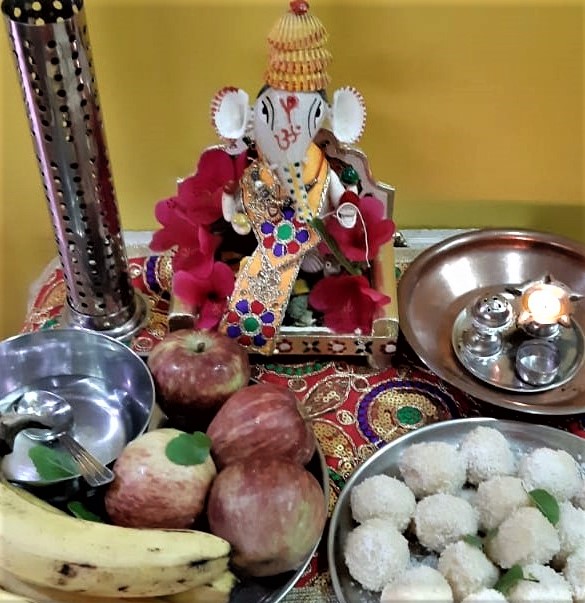
The 4th day after Umasah in the month of Bado is celebrated as Ganesh Chaturthi. Lord Ganpati is worshipped by the devotees by installing a clay idol of Ganesha. The devotees pray to Lord Ganesha to remove all evils and obstacles of life and offer modaks or ladoos, Ganpati’s favourite food and other sweets and fruits. The idol is immersed with much fanfare in a water source after 10 days. Some do so on the first day itself, others after 3, five or seven days. Though traditionally celebrating Ganesh Chaturthi has always been significant among Sindhis, the bringing home of the Ganpati idol and its subsequent immersion is a Maharashtrian influence.
12. Sinha Satte (August-September)
This day falls on the seventh day after Umasah in the lunar month Bado. Much like Raksha Bandhan, Sinha Satte celebrates the bond between the brother and sister. On this day, the sister applies tilk (tilak – the sacred red dot on the forehead) to her brother, feeds him sweets and the two exchange gifts. The sister prays for the protection of her brother.
13. Mahalakshmi -jo- Sagro (August-September)
This falls on the 8th day after Umasah in Bado. A sacred thread called Sagro is tied on the wrist which is removed with a puja after sixteen days. The Sagro is made of sixteen threads dipped in turmeric water and has sixteen knots. Devotees fast on this day and worship Goddess Mahalakshmi for prosperity and good health. On the eighth day after Poonam, the thread is untied and moniyu or pakaan are distributed to the priest and the poor.
14. Shraadh (September)
Shraadh starts from Poonam of the month Bado to Umasah of the month Assoo, a period of fifteen days. During this duration, Sindhis pay their respect to the departed ancestors and seek their blessings. They offer a variety of food to the priest or bambhan on the tithi of the departed. Some give away grains and clothes to the poor and feed the cows.
15. Norta (Navratri)- Vadda Ekaana (September-October)
This nine-day festival starts from the 1st day to the 10th day after Umasah in the month of Assoo. The Navratri celebrates Goddess Shakti, who is the power behind the Creation, Preservation and Destruction of the universe. She has many forms such as Durga, Kali, Bhavani, Amba, Gauri, Lakshmi, Saraswati, etc – each a powerful representation of energy. Devotees pray to the Goddess and her myriad forms by fasting and worshipping her.
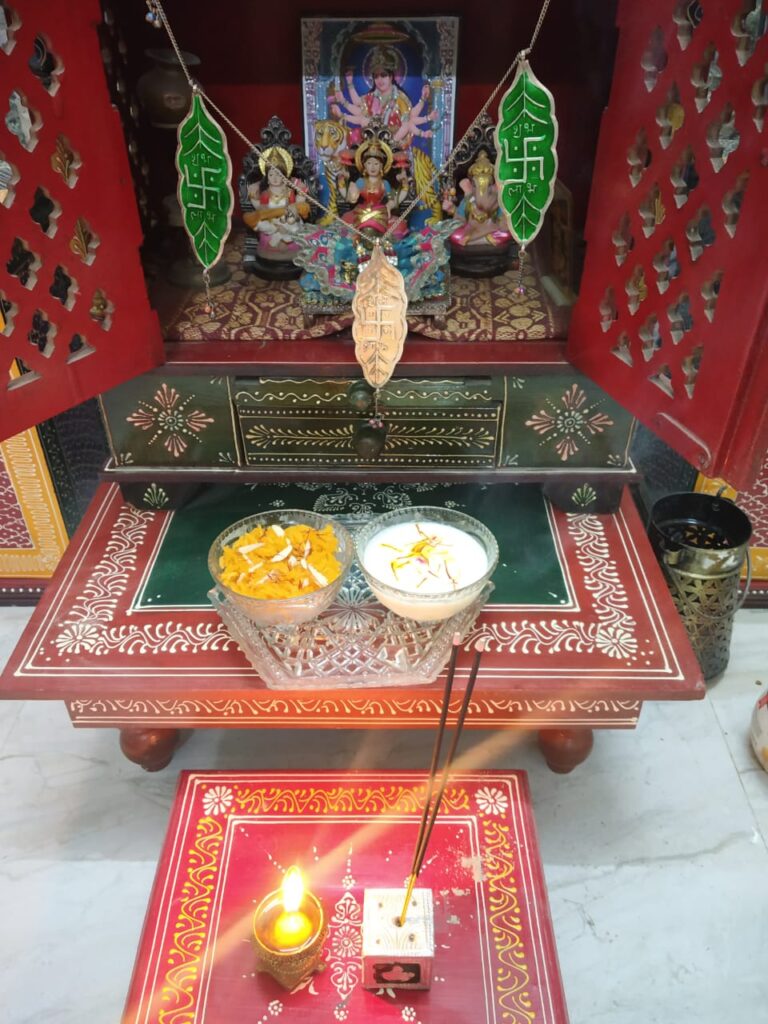
On the seventh day, baakra (sweet moong) is cooked and offered to the Goddess with sev ( gramflour vermicelli) and bhugra (grams).
The eighth day is celebrated as Durgashtmi. Offerings of ghee, kheer (rice cooked in milk) and sesame seeds are done in the havan (holy fire). Eight niyaniyu (young girls) and a kaang (a boy) – all should have not attained puberty- are worshipped and given prasad(offering) of sweet rice and milk. The girls are given gifts of cosmetics or accessories that they can use to adorn themselves. Dakshina (a small amount of money) is given to children.
For these nine days, people eat satvik food (with no onion or garlic) only in the evening after the aarti. They refrain from consuming alcohol or smoking. Men do not shave or cut their hair.
TAYARI (SWEET RICE) AND KHIRNI (SWEET MILK WITH DRY FRUITS AND SAFFRON) OFFERED TO THE GODDESS ON THE EIGHTH DAY
Pic Credit: Diya Davara , Ahmedabad
16. Dussehra (October)
The tenth day after Umasah in the month of Assoo is celebrated as Dussehra, the day Lord Rama vanquished the demon Raavan. The day being auspicious, any new venture can be started. Tools, machines, pens, schoolbooks, etc are placed before the idol of Goddess Durga for her blessings.
Torans (strings) of Ashoka leaves are tied over the front door, cars, etc. Sindhis make samosas on this day.
7. Kartak jo Mahino (October- November)
Kartak is the eighth month of the lunar calendar, one of the holiest months of the year. Some Sindhi devotees wake up before dawn for a bath, fast (ekaana- one satvik meal a day only), offer arg (milk and water) to Suryadev and the Tulsi plant, light a lamp at sunset near the Tulsi and read or listen to the discourses of Bhagvad Geeta.
Arg –An offering made of raw milk and water to sun or moon. Arg is taken in a loto (a container) and poured reverentially on the ground facing the sun or moon while reciting prayers.
The Tulsi Plant-The holy basil or Tulsi is an aromatic plant native to Indian subcontinent. Tulsi is revered among Hindus as a goddess due to its medicinal properties. It has been used in Ayurveda for its treatment of diseases.Tulsi leaves are essential during the worship of all deities, especially Vishnu. A Tulsi leaf is always placed on the prasad and jal before offering it to gods. Tulsi Vivah, the wedding of Goddess Tulsi, is performed in the lunar month of Katti/Karthak.
17. Ddiyaari /Diwali (October-November)
This five -day festival begins on 13th day of Undhaiyu (Krishna Paksh) in the month of Kartak. It is celebrated by all with joy and merriment. People decorate their house, make rangolis, prepare sweets, light earthen lamps, wear new clothes, burst crackers and invite the family to their homes.
The first day of Ddiyaari is Dhanteras which marks the beginning of Diwali celebrations. People buy gold on this day. Some businesses perform chopda poojan -opening of new account books along with Lakshmi Pooja.
The second day is Roop Choudas, when girls and women dress up and beautify themselves.
The third day is Ddiyaari the most awaited day of the year. This day celebrates the return of Lord Ram and Sita from the exile. The people of Ayodhya had celebrated their return and the triumph of good over evil by lighting lamps on the dark night of Umasah.
Goddess Lakshmi is worshipped for wealth and prosperity. Sindhis prepare a festive meal of satbhajiyun (prepared with seven vegetables), pooris and kheer. It is believed that Goddess Lakshmi visits the house the night of Diwali, so a lamp is lit for the entire night. Toys and a picture or an idol of the Goddess are set out on a table or a platform. Some sweets are also placed in a clay container for her to partake.
The fifth day is Bhai Beej when married sisters invite their brothers home for a festive meal and pray for their well-being.
18. Nomiyun and Vaddi Gyaaras / Tulsi Vivah (October – November)
The four days from the eighth day after Umasah referred to as Gop Atthe leading upto the Vaddi Gyaaras are known as Nomiyun. Devotees water the holy peepul tree and the Tulsi plant in the morning and light a lamp near the Tulsi plant in the evening. They fast and worship Tulsi. Cows are fed cotton seeds and dates on Gop Atthe.
The eleventh day after Umasah of the month of Kartak is Vaddi Gyaaras. Goddess Tulsi is married to Shalighram (a stone form of Vishnu/Krishna) on this day. Some celebrate the wedding on Kartak Poonam. The Tulsi plant is dressed as a bride with sari, bangles, bindi, etc. Sindhis worship Goddess Tulsi and Lord Vishnu and seek their blessings.
Rice and rice-based dishes, grains, beans and cereals are avoided. Satvik food with no onion or garlic is prepared.
19. Guru Nanak Jayanti (October- November)
The Kartak Poonam is celebrated as Guru Nanak Jayanti. Sindhis visit the Gurudwara and make Kanaw Prasad to offer to God.
19. Makar Sankranti (January)
This day falls on 14th of January every year and is celebrated to mark the winter solstice.
Some Sindhis celebrate the eve of Makar Sankranti as Lal Lohi when they light a holy bonfire at night and offer coconut, sugarcane, sesame seeds, ghee, etc to the holy fire.
On the 14th, Sindhis do daan of fruits, sugarcane, sesame seeds, puffed rice, berries, carrots and dates. They fly kites and enjoy participating in kite flying competitions. Tiran ja ladoo (sesame seed balls), tiran ji chikki (sesame seed praline), murmuran ja ladoo (puffed rice balls), and a variety of pralines with coconut, peanuts and dry fruits are consumed.
20. Maha Shivratri (February – March)
The Umasah of Faag month is celebrated as Shivratri, the wedding anniversary of Lord Shiv and Goddess Parvati. Devotees fast the entire day and night and worship the Shivling with Bilwa leaves. Thadaal or Thandaai made of almonds and milk is offered to Lord Shiv. Some devotees stay awake the entire night, praying and singing bhajans of Lord Shiv and Goddess Parvati.
21. Holi (February – March)
The Poonam of the month of Faag is Holi. A small holy bonfire of cow dung cakes is lit at home. A whole wheat flatbread is made and tied with white thread. This is then roasted on the bonfire. The bread gets roasted and the thread does not burn symbolising the triumph of good over evil.
The next day, people celebrate the arrival of spring by sprinkling flowers or powdered colours on each other. Some play pranks on each other.
Thanks to Urvashi Dama, Mumbai and Vivek Dalwani, Mumbai for sharing pertinent information on important religious days and rituals.
Thanks to Mrs Veena Gopwani and Mrs. Meena Jagwani for information on Ghoghro.
Reference Book: Glimpses of Sindhiyat –Rituals and Way of Life
Jyoti Muchandani
Ahmedabad

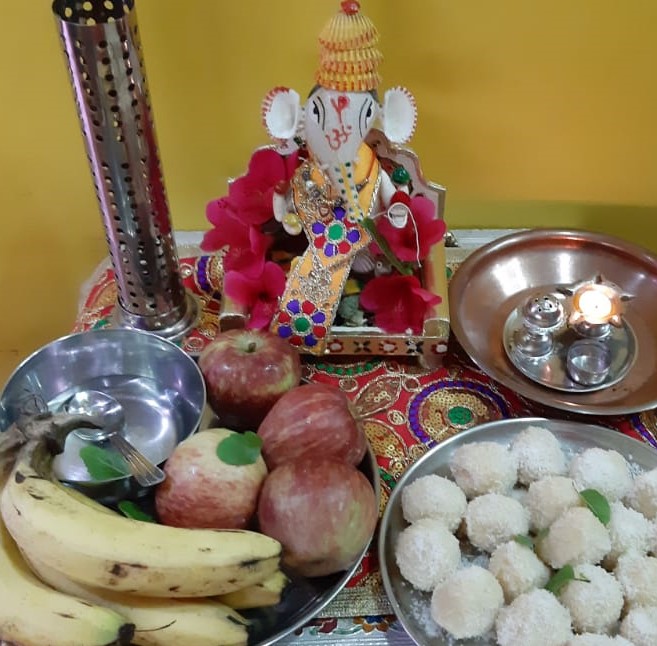
Give a Reply